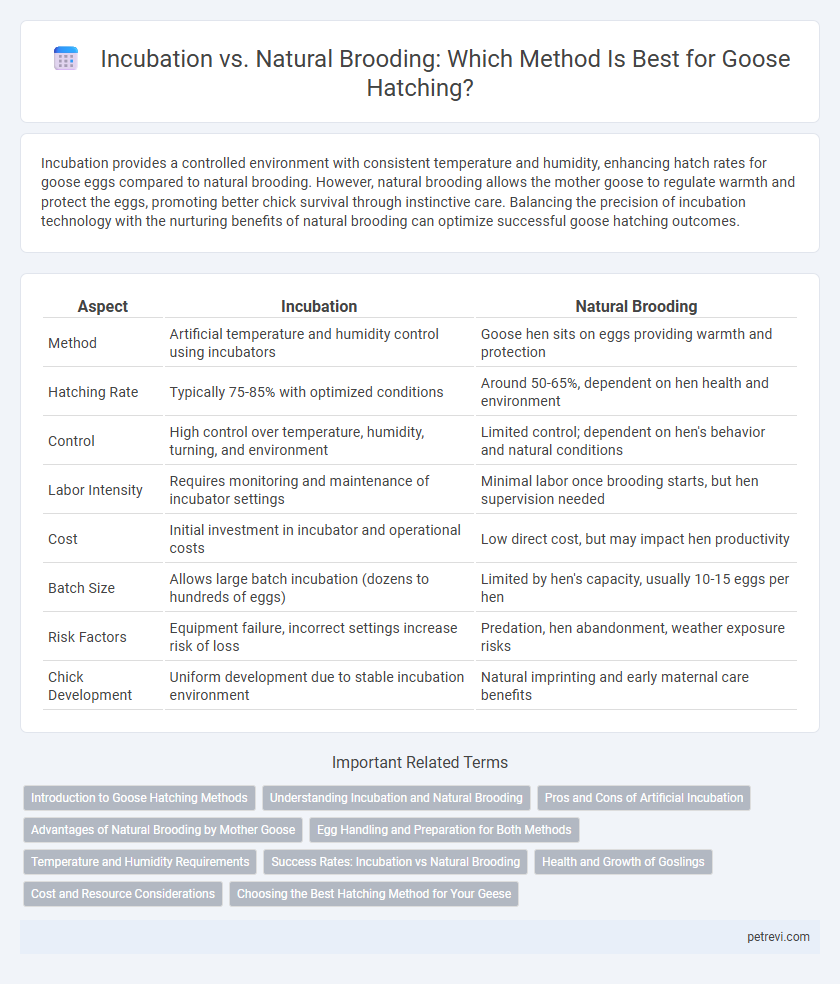Incubation provides a controlled environment with consistent temperature and humidity, enhancing hatch rates for goose eggs compared to natural brooding. However, natural brooding allows the mother goose to regulate warmth and protect the eggs, promoting better chick survival through instinctive care. Balancing the precision of incubation technology with the nurturing benefits of natural brooding can optimize successful goose hatching outcomes.
Table of Comparison
| Aspect | Incubation | Natural Brooding |
|---|---|---|
| Method | Artificial temperature and humidity control using incubators | Goose hen sits on eggs providing warmth and protection |
| Hatching Rate | Typically 75-85% with optimized conditions | Around 50-65%, dependent on hen health and environment |
| Control | High control over temperature, humidity, turning, and environment | Limited control; dependent on hen's behavior and natural conditions |
| Labor Intensity | Requires monitoring and maintenance of incubator settings | Minimal labor once brooding starts, but hen supervision needed |
| Cost | Initial investment in incubator and operational costs | Low direct cost, but may impact hen productivity |
| Batch Size | Allows large batch incubation (dozens to hundreds of eggs) | Limited by hen's capacity, usually 10-15 eggs per hen |
| Risk Factors | Equipment failure, incorrect settings increase risk of loss | Predation, hen abandonment, weather exposure risks |
| Chick Development | Uniform development due to stable incubation environment | Natural imprinting and early maternal care benefits |
Introduction to Goose Hatching Methods
Goose hatching methods primarily involve incubation and natural brooding, each playing a crucial role in embryo development and hatchling survival. Incubation offers controlled temperature and humidity, enhancing hatch rates for commercial purposes, while natural brooding relies on the mother goose's body heat and behavior, supporting instinct-driven care and stronger gosling imprinting. Understanding these methods is essential for optimizing goose reproduction and ensuring healthy offspring in agricultural or conservation settings.
Understanding Incubation and Natural Brooding
Incubation of goose eggs involves maintaining precise temperature and humidity levels, typically around 37.5degC and 55-65% humidity, to mimic natural conditions and ensure optimal embryo development. Natural brooding allows the mother goose to regulate heat and provide protection, which can enhance hatchling survival rates through instinctive behavior and movement adaptation. Understanding these differences helps optimize hatching success by balancing technological control with natural maternal instincts.
Pros and Cons of Artificial Incubation
Artificial incubation for goose hatching offers controlled temperature and humidity, increasing hatch rates and reducing disease risk compared to natural brooding. However, it requires specialized equipment and constant monitoring, which can increase operational costs and technical challenges. Natural brooding allows mother geese to exhibit instinctive care, resulting in better chick socialization, but it risks higher mortality from environmental factors and predators.
Advantages of Natural Brooding by Mother Goose
Natural brooding by a mother goose ensures optimal temperature regulation and humidity control, critical factors for successful egg incubation and embryo development. This method also offers protection from predators and environmental hazards, increasing hatchling survival rates. Furthermore, goslings benefit from early social bonding and learning behaviors under maternal care, enhancing their growth and adaptability.
Egg Handling and Preparation for Both Methods
Egg handling and preparation for incubation require precise temperature and humidity control, along with careful turning of eggs to ensure uniform embryo development. Natural brooding relies on the goose's body heat, necessitating minimal disturbance and gentle handling to avoid chilling or damaging eggs. Both methods benefit from selecting clean, properly fertilized eggs and maintaining a stable environment to maximize hatching success.
Temperature and Humidity Requirements
Optimal incubation for goose eggs requires maintaining a consistent temperature range of 37.5degC to 38degC and relative humidity levels around 55-65% during the first 25 days, increasing humidity to 70% in the final days to prevent membrane drying. Natural brooding exposes eggs to slightly fluctuating temperatures influenced by the mother's body heat, typically around 36.5degC to 37.5degC, with humidity regulated by nest environment and maternal behavior, often resulting in more variable conditions. Controlled incubation offers precise climate management, crucial for uniform embryo development and hatchability, while natural brooding relies on instinctual behaviors and environmental factors to meet temperature and humidity needs.
Success Rates: Incubation vs Natural Brooding
Incubation of goose eggs in controlled environments achieves success rates up to 85-90% due to precise temperature and humidity regulation. Natural brooding success rates vary between 65-80%, influenced by the health and behavior of the mother goose and environmental conditions. Controlled incubation minimizes risks like temperature fluctuations and predation, enhancing overall hatchability compared to natural brooding.
Health and Growth of Goslings
Incubation offers controlled temperature and humidity, reducing risks of infection and promoting consistent embryo development, which enhances gosling health and uniform growth rates. Natural brooding allows goslings to receive maternal warmth and protection, supporting stronger immune systems and reducing stress, fostering better early-life growth and survival. Studies show artificially incubated goslings may require additional care to mimic natural behaviors critical to optimal health and development.
Cost and Resource Considerations
Incubation of goose eggs requires initial investment in equipment and consistent energy consumption, but reduces the need for extended caretaker labor compared to natural brooding. Natural brooding incurs lower upfront costs but demands continuous human or foster goose management, impacting overall labor resources. Cost efficiency depends on the scale of operation and availability of reliable brooding conditions versus electricity and maintenance expenses for incubators.
Choosing the Best Hatching Method for Your Geese
Choosing between incubation and natural brooding for goose hatching depends on factors like control over temperature and humidity versus maternal care. Incubation offers precise environmental regulation, increasing hatch rates and reducing risks of egg damage, while natural brooding provides the warmth and protection from the goose mother, promoting stronger gosling survival. The best method hinges on your resources, desired hatch quantity, and ability to replicate optimal conditions for healthy offspring.
Incubation vs Natural brooding for Goose hatching Infographic

 petrevi.com
petrevi.com